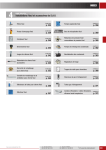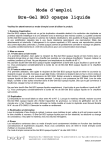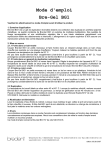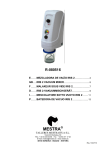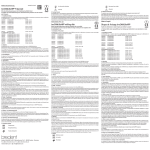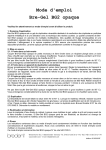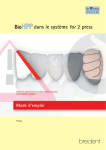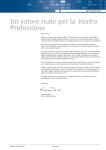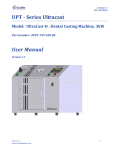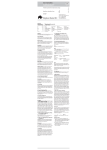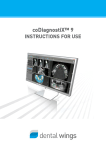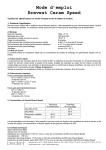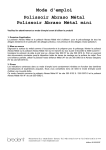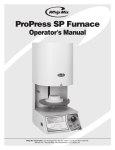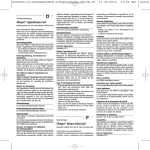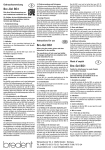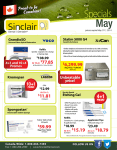Download in for2press system
Transcript
SYSTEM in for2press system Processing instructions English Please read these processing instructions and the associated user manual carefully prior to using the product! Contents Introduction......................................................................................... Important information ..................................................................... Safety information ............................................................................ 3 3 3 The unit .................................................................................... Set-up and operation ....................................................................... Location of the for2press unit ....................................................... Adjusting the air brake ..................................................................... 4 4 4 4 Preparing the framework ........................................................ Preparing the tooth stump .............................................................. Temporary moulds ............................................................................. 5 5 5 Preparing the framework ........................................................ Insulating the plaster model........................................................... Material thickness, connector cross-sections and framework geometry......................................................................... Connector cross-section design .................................................... Mould showing distribution of chewing forces ........................ Basal rest mould on the gums ....................................................... Connector design*.............................................................................. 6 6 Mould spruing .......................................................................... Insulate mould plate with Vaseline .............................................. Spruing.................................................................................................. Investment options............................................................................ 8 8 8 8 Spruing version 1: Removal procedure.................................. Positioning in the mould plate....................................................... 9 9 6 6 6 7 7 Spruing version 2: Model over-pressing technique (size 9) . 10 Creating the duplicate model....................................................... 10 2/28 Spruing version 3: Model over-pressing technique mould set MP (size 10) ..................................................................... Creating the duplicate model....................................................... Positioning on the base plate ....................................................... 12 12 12 Mixing and investment ......................................................... Controlling the expansion of the investment material......... Investment ......................................................................................... 14 14 15 Preheating .............................................................................. Recommendation: Setting the temperature of the preheating furnace .......................................................................... Preheating process of the investment material mould ......... Filling capacity.................................................................................. Melting the material ....................................................................... 16 Pressing process with for2press ........................................... Attaching the press plunger ........................................................ 18 18 Removing the investment material...................................... Soaking ............................................................................................... Devesting process ............................................................................ 20 20 20 Fitting and finishing.............................................................. 20 Veneering with composites ................................................... 22 Cleaning .................................................................................. 23 Framework insertion ............................................................. Summary of potential bonding and fixing materials............. 24 24 Order information ................................................................. 25 Troubleshooting ................................................................... 26 FAQ ......................................................................................... 27 16 16 17 18 T: +49 (0) 73 09 / 8 72-4 41 · F: +49 (0) 73 09 / 8 72-4 44 · www.visio-lign.com · @: [email protected] Introduction The following instructions contain all the information needed to process BioHPP in the for2press unit. The protocols listed here enable the manufacture of prosthetic work using BioHPP while maintaining the characteristics of the polymer in the end product. The vacuum press system for2press automatically performs the pressing process and subsequent cooling of the mould under pressure and under vacuum. Only use the system components of the for2press system, such as the "brevest for2press" investment material, the "for2press filler" press plunger, the "for2press mould set" investment material moulds and the metal reinforcement ring. Important information Symbols: The processing instructions include symbols as well as ! special warnings, with special processing tips to enable easier processing. Safety information Appropriate use: The for2press system is intended to be used for the indications described in the user manual. Any other use will be considered as improper use. Use of heat protection gloves, dust mask and safety glasses is strongly recommended when using this system. User qualifications: Users who work with the system must • be appropriately trained for the relevant activities. • know the relevant safety procedures. It must be ensured that these processing instructions are always available for the user. Please also note the operating and maintenance instructions for the for2press vacuum press unit REF 140 0061 0. 3/28 The unit Set-up and operation (see the device instructions included) Compressed air unit and inlet pressure of min. 4.5 bar to max. 6 bar Ensure that the compressed air maintenance unit supplied with the basic set is connected to the rear side of the for2press and that the inlet pressure is set to a maximum of 6 bar. This compressed air maintenance unit also cleans the compressed air and removes moisture from it. It thus protects the pneumatic sensors and control units of the for2press vacuum press unit. ! It is important to check beforehand whether any other users may have changed the pressure setting. The dynamic air inlet pressure in the cable must not fall below 4.5 bar or exceed 6 bar. Location of the for2press unit BioHPP is not melted in the for2press unit but in a preheating furnace. To avoid heat loss when the mould is moved from the preheating furnace to the pressing unit, we recommend that the pressing unit is positioned close to the preheating furnace. Transfer time to the pressing unit: maximum 10 seconds (comparable to casting alloys). Adjusting the air brake Prior to first use, the screws that operate the pressing table's brakes (to be found underneath the table) need to be gently tightened. You only need to check this occasionally. ! 4/28 1 2 The pressing table must not come down too quickly, otherwise the moulds could be damaged by the impact. If this happens, the air brake should be tightened using the set screws. Tip: a weight of around 600 g helps to control the air brake on the pressing table! T: +49 (0) 73 09 / 8 72-4 41 · F: +49 (0) 73 09 / 8 72-4 44 · www.visio-lign.com · @: [email protected] = approx. 3 x Preparing the framework Preparing the tooth stump In order to provide optimum support to the framework, a chamfer or shoulder preparation is required (Fig. 1+2). A tangential preparation is not recommended (Fig. 3). 1 2 3 Temporary moulds To produce temporary moulds, we recommend the use of all conventional waxes and modelling resins that burn completely without residue. 1 Modelling resin is suitable for making temporary moulds for crown and bridge frameworks and superstructures, e.g. bar assemblies or Toronto bridges, but not for over-pressing titanium bases; these abutments should be moulded in wax. Resin should be chosen which does not significantly increase in volume during the burning process, so that the investment materials are not put under too much stress. Therefore, when resins are used, a wax layer should also be applied to compensate for the expansion, particularly for very large frameworks. ! Caution! Modelling resin must not be used for titanium abutments as the preheating temperature of 630°C is not sufficient for the modelling resin to burn without leaving any residue. When producing the framework for subsequent veneering with composite veneers, the temporary mould for the framework must be anatomically scaled down. The minimum material thickness for BioHPP is 0.6 mm. For optimum accuracy in the fit around the preparation margin (crown margin), the circular modelling in that area needs to be increased. This area can be tapered and reduced to 0.3 mm after the pressing process. When producing temporary moulds for back protection plates for veneering, the transition must be positioned outside the functional surface for veneering. Sharp-edged transitions in the mould must be avoided. Moulding scalloped edges has proven successful for veneer bridges in the anterior and posterior areas in order to increase stability. (Fig. 1) 22 It is recommended that retaining elements (coarse retention splinters or large retention beads) are also attached to the surface to be veneered (Fig. 2). Evenly distributed retention crystals. Image: Dentec Allergielabor Ehrenkirchen, Jens-Christian Fehsenfeld, (DE) 5/28 Preparing the framework Insulating the plaster model Conventional wax insulation has proven to be suitable when using modelling wax. If the temporary mould is made of modelling resin, Vaseline must be used for the insulation. Material thickness, connector cross-sections and framework geometry BioHPP Minimum circular framework thickness Minimum occlusal framework thickness Connector thickness Geometric proportion of pontics (horizontal/vertical) Anterior crowns Posterior crowns Primary telescop- Secondary teleic crowns scopic crowns 4-unit anterior bridges 4-unit posterior bridges Bar attachments > 0.6–0.7 mm > 0.6–0.7 mm > 0.6–0.7 mm > 0.6–0.7 mm > 0.6–0.7 mm Abutment tooth > 0.6–0.7 mm > 0.8 mm > 0.6–0.7 mm > 0.8 mm > 0.6–0.7 mm > 0.6–0.7 mm > 0.6–0.7 mm Abutment tooth > 0.6–0.7 mm > 0.8 mm — — — — > 12 mm2 > 14 mm2 — — — — —. 40/60 % 40/60 % — Connector cross-section design Posterior region connectors: Anterior region connectors: min. 14 mm² min. 12 mm² 1 min. 14 mm2 In the posterior region, the connector thickness of the wax model between pontics or between the pontic and the crown must cover a minimum area of 14 mm². In the anterior region, the connector thickness of the wax model between pontics or between the pontic and the crown must cover a minimum area of 12 mm². The distribution between the vertical and horizontal areas must be approx. 60% to 40%. ca. 3.5 mm The largest framework diameter from the occlusal to the basal area should be along the axis of the central fissure. This is important for the stability of the framework. The elastic behaviour is thus restricted by up to 2 pontics, which also ensures the adhesive bond between the veneering resin and the BioHPP. Mould showing distribution of chewing forces As shown in figures 1 and 2, the largest diameter from the occlusal to the basal areas should be along the axis of the central fissure. This is important for the stability of the framework. Creating a shape like a flute mouthpiece should be avoided. 6/28 1 T: +49 (0) 73 09 / 8 72-4 41 · F: +49 (0) 73 09 / 8 72-4 44 · www.visio-lign.com · @: [email protected] 2 ca. 4 mm Basal rest mould on the gums We recommend not veneering the basal application of the bridge pontics on the gingiva of the alveolar ridge with composite veneers. This area must be designed from BioHPP in order to ensure the greatest possible strength in the vertical extension. In the transitions from the composite veneer to the BioHPP framework material, an undercutting retentive end strip must be modelled using a wraparound technique (Fig. 3). The BioHPP has extremely good polishing properties, making direct contact to the gingiva possible. 3 Connector design* Oral view • Veneering resin in the buccal basal area should not project beyond the basal BioHPP layer • Even veneering thickness, supported everywhere by framework • Veneering should not taper off sharply • Veneering in the connector area should not have wide or sharp separations • The basal pontic area should not be veneered • Height: > 3.7 mm • Width: > 3.5 mm Veneering (composite): • Even layer thickness • 1–2 mm • Round cusp formation (anatomically shaped, but not too angled) 4 Palatinal view 5 Framework (BioHPP): • Anatomically shaped • Supports the veneering • Round design Section Tooth stump preparation options: • Wedge with rounded interior edge • Accentuated chamfer Not veneered 5 * University of Regensburg UKR, Dr. Rosentritt (DE) Image: Schwindt Dentallabor, Landau/Pfalz (DE) 7/28 Mould spruing Insulate mould plate with Vaseline ! To facilitate the subsequent removal of the mould plate or the press plunger spacer from the investment material, we recommend slightly greasing the mould plate and the vertical press plunger spacer with Vaseline. 1 Spruing ! Do NOT use casting bars or casting pears! 2 Only a few short sprues with a larger diameter (e.g. 4–5 mm) should be attached to the areas of the mould that have the largest volume. For larger structures, the sprues should be positioned symmetrically and evenly on at least every other element, so that the pressure during the cooling process is evenly distributed. It is recommended that a bar (diameter 2 mm) made from hard wax is placed so that it provides a dorsal link on the section between the last elements, thus preventing potential tension. Add two air channels leading from the last two elements towards the mould plate. Summary of the most important spruing parameters 3 4 Single crown, individual abutment, 4-unit bridges, model over-pressing technique (PressOverModel) Wax wire diameter Sprue length Layout of attachment points Distance between several objects Distance between the mould and the edge and top of the ring 4–5 mm max. 5 Conical, with no sharp edges or corners 3–3.5 mm (except model over-pressing) 10 mm In Figures 3 + 4, an individual abutment is sprued using the "perfect2press" (REF 430F2P30) specially formed, spiral sprue. These special sprues are very well suited for use with BioHPP granules. They prevent individual granules from falling into the mould too soon and ensure homogenisation during the pressing process as well as preventing air pockets. Investment options Investment can be carried out in two different ways. Either the resin or wax mould is taken from the master model and completely invested (Fig. 5), or the mould is made using an investment material duplicate model as per the model casting technique and subsequently invested (Fig. 6). 5 Removal procedure 8/28 6 Model over-pressing technique T: +49 (0) 73 09 / 8 72-4 41 · F: +49 (0) 73 09 / 8 72-4 44 · www.visio-lign.com · @: [email protected] Spruing version 1: Removal procedure Positioning in the mould plate To reduce the risk of the mould bursting, as much of the investment material as possible should remain on the object to be pressed. If the hollow space in the mould is too large, this can lead to instability resulting in damage to the mould wall. Model pressing: for some moulds/indications, e.g. telescopic secondary designs, the modelling of the secondary part is performed on an investment material duplicate model. In this case, it is important that the investment material model is significantly reduced in order to provide as much space as possible for the investment coverage. This significantly reduces the risk of the mould bursting – see the chapter on the model over-pressing technique. 1 2 To obtain flawless pressing results, the following points must be observed: • The object must be placed outside the heat centre (Fig. 1) • The distance between the object and the inside of the metal ring must be at least 5 to 10 mm (Fig. 2) • The distance between the object and the upper edge of the mould ring must be at least 10 mm (Fig. 3) 5 - 10 mm 3 10 mm ! No sharp transitions to the objects. ! In order to avoid the risk of mould separations in one plane, it is recommended that, when moulding several, larger objects, these are placed in the mould at different heights. 9/28 Spruing version 2: Model over-pressing technique (size 9) Creating the duplicate model Recommended concentration: 65–75% 65–75% 1 2 3 4 Investment material model Investment coverage The EBM model can be removed from the mould after 25 min. 5 6 The EBM should now be reduced and then dried at max. 80 °C for 30 min. Minimum framework thickness: Secondary telescope: Secondary constructions: circular occlusal > 0.6–0.7 mm > 0.6–0.7 mm > 0.8 mm > 0.8 mm 7 The transitions from the veneering composites to the BioHPP should be made using a wraparound technique, showing the 'undercut'. 10/28 8 It is recommended that the basal and vertical aspects of the EBM model are reduced to the minimum size required. T: +49 (0) 73 09 / 8 72-4 41 · F: +49 (0) 73 09 / 8 72-4 44 · www.visio-lign.com · @: [email protected] Investment mould set size 9 Summary of mixing parameters: Model over-pressing technique Wax wire diameter: Sprue length: Design of attachment points: Distance between several objects: Distance between the mould and the edge and top of the ring 4–5 mm max. 5 mm no sharp edges or corners — 9 10 10 mm It is recommended that retentions are attached to the surface to be veneered. 11 It is recommended that a bar made from hard wax is placed at the end. For the investment coverage, 3 bags of Brevest for2press (total 630 g) and 159 ml of Bresol (concentrate & dist. H2O) for2press are required. 13 It is important to use short sprues for spruing. 12 It is recommended that the sprues are attached to the radius of the press plunger reservoir. 14 11/28 Spruing version 3: Model over-pressing technique mould set Creating the duplicate model Recommended dosage of Bresol for2press with dist. water: 1 Recommended concentration: 65–75% 65–75% Investment material model Investment coverage Mixing ratio: For the investment coverage, three 210 g bags (a total of 630 g of Brevest for2press with 159 ml of Bresol for2press) are required. Do not use any casting pears, instead use wax sprues that are as short and thick as possible, or the optional spiral-shaped perfect2press wax sprues. Figure 1 shows the investment material duplicate model made from Brevest for2press. After pouring out the silicone duplicate, the model needs to dry for at least 30 min. The model can then be removed from the silicon duplicate mould. The model can also be dried at a maximum of 80°C for 30 min. Positioning on the base plate It is recommended that the underside of the model is prepared with either wax or modelling material, as appropriate (Fig. 2). A small gap should be left under the investment material model, to be filled with the investment material in the coverage process. This ensures a sufficient bond between the model and the investment coverage. To fix the sprues to the press plunger spacer, simply shorten them using a hot modelling knife. (Fig. 3). The investment material model must be placed in the centre of the base former, leaving a circular space between it and the metal ring of at least 5 mm. This leaves enough space for coverage with the investment material. The transparent height limiter with the access window is slid sideways onto the base plate. The window enables the press plunger spacer to be more easily held in place from all sides. 12/28 2 3 4 T: +49 (0) 73 09 / 8 72-4 41 · F: +49 (0) 73 09 / 8 72-4 44 · www.visio-lign.com · @: [email protected] MP (size 10) Investment mould set MP size 10* Positioning in the mould plate The centring aid for the press plunger spacer is simply attached to the transparent height limiter. 5 Using the centring aid, the press plunger retainer is aligned precisely in the middle of the wax sprues. The transition from the cylindrical to the conical section of the press plunger spacer marks the maximum depth. The wax sprues should then be fixed with the press plunger retainer. After the press plunger spacer has bonded with the wax sprues, the centring aid can be lifted off the top. After the centring aid and the height limiter have been removed, the silicone fixing ring can be attached to the base plate. The round groove on the silicone fixing ring fits precisely into the base plate. 9 6 7 8 10 * only possible with for2press 2 unit 13/28 Mixing and investment Controlling the expansion of the investment material General mixing ratios Recommended dosage for Bresol for2press investment material liquid. 210 g of Brevest for2press (1 bag) = 53 ml of Bresol for2press liquid Brevest for2press investment material has been specially developed for processing BioHPP with the for2press unit. Quantity Mixing concentrate 210 g (size 3) Bresol for2press liquid 420 g (size 9) distilled water Bresol for2press liquid 630 g (size 10) distilled water Bresol for2press liquid 55% 29 24 58 48 87 72 70% 37 16 74 32 111 48 100% 53 0 106 0 159 0 Recommended concentrations Removal technique 50% to 55% liquid = single crowns and bridges 70% to 80% liquid = secondary parts (telescopic) and tertiary constructions Model over-pressing technique 65% to 75% liquid = investment material for over-pressing technique If you thin the mixing liquid with demineralised water, this will reduce expansion. All values are intended as a guide. The precise adjustment of the concentrate is to be done based on the prevailing environmental conditions and indications in the laboratory. Mixing the investment materials: Investment materials and liquid are to be stirred by hand for approx. 30 seconds. Vacuum mixer: We recommend that where possible, you use a prevacuum (approx. 10 sec.) Rpm: approx. 390 r/min. Mixing time: 90 seconds under vacuum 14/28 distilled water T: +49 (0) 73 09 / 8 72-4 41 · F: +49 (0) 73 09 / 8 72-4 44 · www.visio-lign.com · @: [email protected] Investment Removal technique To prevent air pockets inside the crowns, it is recommended that a suitable brush or a special "transfuser" (REF 390S0001) is used during the investment process. This ensures that the crown interior is free of bubbles. 1 (Fig. 1). ! When using a metal mould, a protective fleece liner at least 1 mm thick should be attached. (REF 360 F2PV 1, REF 360 F2PV 2, REF 360 F2PV 3) 2 The whole mould can then be filled with EBM (Fig. 2). After a 25 min. setting time, the hot mould is removed from the resin base former using a slight turning motion (Fig. 3 and 4). Please always remove the mould keeping the opening facing downwards. This prevents the risk of investment material parts entering the mould. ! Check the right angle To ensure that the pressing process runs smoothly, the mould needs to be kept straight and at a right angle. It may be necessary to trim the mould on the opposite side from the filler opening, to ensure that the mould remains straight during the pressing process. It should be at a 90° angle (Fig. 5). 4 5 90 ° If the size 3 mould set is used without a metal ring, only a silicone ring can be used (Fig. 3). 3 Model over-pressing technique Once the metal ring has been lined with a 1 mm insert (REF 360F2PV1), it can be filled with a total of 630 g of investment material, mixed with 159 ml of mixing liquid (65% to 75%). (Fig. 6) Once the coverage has cured for 25 min., the press plunger spacer can be removed from the investment material mould (Fig. 7). 6 7 15/28 Preheating Recommendation: Setting the temperature of the preheating furnace Application Recommended max. temperature Modelling material Heating-up rate Waiting times/ mould size Ø 3 (16 cm) Over-pressing titanium bases All other applications Speed Wax Directly into the hot furnace Conventional Wax 8°C/min. Stopping times at 290°C at 580°C Directly into the hot furnace 630°C 850°C – Speed 900°C 850°C – Conventional 900°C Wax Resin Wax Resin 8°C/min. Stopping times at 290°C at 580°C Benefits 9 + 10 (26 cm) Up to four hours, faster, more delicate structures can be devested. 45 min. 45 min. 60 min. 60 min. smoother surface, more stable mould 45 min. 45 min. 60 min. 60 min. Next, reduce the temperature of the furnace to 400°C and hold for an hour to allow the BioHPP to melt. When using a metal ring, the hot mould can be transferred directly into a second furnace preheated to 400°C (time-saving). Preheating process of the investment material mould Speed heating process: The setting time of the investment material is 25 min. For the speed process, the mould is then placed directly into a preheating furnace that has been set to the end temperature. The optimum preheating temperature is around 850°C–900°C. At this temperature, the investment material has maximum stability due to the fused quartz. The preheating temperature of 630°C is only used when investing titanium parts such as elegance abutments. At 630°C, the formation of an oxide layer is minimised. The press plunger must also run through the same entire preheating process as the mould. After the holding time at the end temperature of 45 min. for a size 3 mould and 60 min. for a size 9 mould, the furnace is cooled to 400°C and then held for another 60 min. The max. cooling speed of 5°C/min must not be exceeded as this could affect the stability of the investment material mould. This cooling speed is maintained if the furnace door remains closed the whole time. The mould is now ready for the BioHPP melting process. 16/28 T: +49 (0) 73 09 / 8 72-4 41 · F: +49 (0) 73 09 / 8 72-4 44 · www.visio-lign.com · @: [email protected] Preheating process of the investment material mould Conventional heating process: After allowing to set for 25 min., the mould can be placed in the cold preheating furnace. The max. heating-up rate of 8°C/min should not be exceeded. In order to precisely control the expansion of the investment material during the conventional heating-up process, the guide times of 290°C for 45 min. and a second stage of 580°C for another 45 min. must be adhered to. Once the end temperatures of 630°C and 850°C have been reached, the holding time for a size 3 mould is at least 45 min. and for a size 9 mould, at least 60 min. If several moulds are preheated at the same time, the holding time per mould increases by around 10 minutes. After this holding time, the mould is slowly cooled down, with the furnace door shut, to 400°C at a speed of 5°C per minute. When using a metal ring, the mould can be transferred directly into a second furnace at 400°C. ! Caution! When investing titanium patterns, such as the individual BioHPP elegance abutment, a maximum end temperature of 630°C must not be exceeded, as otherwise an Alpha Case layer will form! Filling capacity Wax/BioHPP granules conversion table BioHPP delivery form Size 3 base mould with 16 mm press Size 9 base mould with 20 mm press Size 9 base mould + size 10 with plunger diameter plunger diameter 26 mm press plunger diameter Mould weight <1g <2g <3g <4g >5g Granules 3g max. 4.5 g 7.5 g max. 9 g smoother surface, more stable mould 15 mm pellet (4 g each) 1 pellet 1 pellet 2 pellets 2 pellets 25 mm pellet (15 g each) not possible 3 pellets 1 pellet 17/28 Preheating Melting the material Fitting the BioHPP disposable press plunger to the mould Once the mould has been in the preheating furnace for an hour at 400°C, the sprues can be filled with granules or pellets. It is then put back in the preheating furnace for another 20 min. (filled with BioHPP) at 400°C. ! Melted or used material should never be used. The material would degrade during another melting process and important physical qualities would be lost. If the melting time or temperature is exceeded, the BioHPP will be darker than at the beginning of the process. Melting time (BioHPP): 20 min. ! 1 2 Note: if the material turns darker, it can no longer be used and must be replaced. Pressing process with for2press Attaching the press plunger When fixing the mould with the disposable press plunger (for2press filler), the surface with the identification mark must face upwards (Fig. 1). This ensures that the rounded edge of the plunger goes into the mould. This prevents the plunger from tilting during the pressing process (Fig. 2). 1 The mould containing the melted BioHPP is then immediately transferred into the pressing unit. Please avoid placing the preheating furnace and the pressing unit a long way apart! 2 90 ° Before pressing with for2press The set parameters, such as the pressing force or the vacuum time, must be checked before each pressing process. 18/28 T: +49 (0) 73 09 / 8 72-4 41 · F: +49 (0) 73 09 / 8 72-4 44 · www.visio-lign.com · @: [email protected] Pressing process with for2press Attaching the press plunger Inlet pressure: 4.5–6 bar Vacuum time (BioHPP): 3 minutes (preset) for2press 5 minutes (preset) for2press 2 3 Force: Mould size Press plunger diameter in mm Force in bar Size 3 16 2.5 Size 9 26 4–5 Size 10 26 4–5 The mould assembled for the pressing process is placed on the pressing table of the for2press unit. Manually closing the pressing chamber by moving the pressing table upwards with both hands starts the pressing process, which runs automatically for 40 minutes, including the cooling phase. 4 The vacuum chamber is automatically evacuated before the pressing chamber is closed. The status light changes from blue to red and the pressing process begins once the maximum vacuum has been reached. Push the pressing table firmly upwards until the silicon seal fits all the way round and the LED status light changes from blue to red. Once the pre-set vacuum time has finished, the pressing table will automatically lower into the cooling position and the cooling phase will start, while maintaining the pressing force. The cooling phase under pressure lasts for 40 min. The whole pressing process finishes with an acoustic signal, the LED display changes from red to blue and the press plunger is automatically raised into the stand-by position. The pressed mould can now be removed from the unit. The unit is ready for the next pressing process. ! Interrupting the programme while it is running using the 'Stop programme' button, just to save time, should always be avoided. This button stops the whole programme. Prematurely interrupting the pressing time would have a negative effect on the pressed material's physical properties. The 'Stop programme' button should only be used if, for example, the mould in the unit is not straight or a vacuum cannot be generated due to dirt on the silicone seal. 19/28 Removing the investment material Soaking Soaking the mould for approx. 10 min. in a water bath makes the devesting process easier and significantly reduces the amount of dust generated. Devesting process The mould can be roughly devested using a hammer. The remaining investment material must be removed with a pneumatic devesting chisel. No distortion takes place, such as with dental casting alloys, due to the elastic material properties of BioHPP. 1 The rest of the investment material is sandblasted with 110 µm aluminium oxide grit at 2.5 bar. During the sandblasting process, the distance between the object and the jet nozzle must be at least 3 cm (Fig. 2). If the distance is any smaller, parts of the resin could become heated and damaged. ! Caution! When using titanium bases that can be over-pressed (elegance abutment) for individual abutments, the remaining investment material must be removed using 50 µm polishing beads instead of 110 µm Al2O3 at a sandblasting pressure of 2.5 bar (Fig. 3). Abrasives must not be used on the abutment joints. A cover can be made for this section using a bolted-on laboratory analogue. It is recommended that the remaining investment material is loosened in an ultrasound bath. ! The mould rings do not fit into the normal devesting presses but can be easily removed from the mould. Fitting and finishing 2 3 4 For wide-span objects, it may be beneficial if the sprues are not removed during the fitting process. These can provide an extremely firm hold. After fitting, the sprues can be most easily removed with cross-toothed mills. Generally, the object is fitted to the stumps without using occlusal spray or similar aids, as these chemical substances are difficult to remove from the objects. A perfect high gloss polish ensures optimum surface quality. 20/28 T: +49 (0) 73 09 / 8 72-4 41 · F: +49 (0) 73 09 / 8 72-4 44 · www.visio-lign.com · @: [email protected] Fitting and finishing The following five steps using selected rotating tools will lead to optimum results: Step 1 1 Carbide cutter, coarse serration, light contact pressure, 6–8000 rpm. REF Designation H200 M8 23 Carbide cutter 2.3 mm Ø – rounded conical H272 M8 14 Carbide cutter 1.4 mm Ø – garnet H274 M8 40 Carbide cutter 4.0 mm Ø – garnet H237 M8 23 Carbide cutter 2.3 mm Ø – garnet 350 00M2 5 Diamond disc 0.25 mm Ø Giflex-TR Master x-tray 2 Step 2 Diagen-Turbo-Grinder, green, light contact pressure, 6–8000 rpm. REF Designation 34000200 Diagen-Turbo-Grinder Step 3 Ceragum rubber polishing cylinder, light contact pressure, 6–8000 rpm. Caution: very light contact pressure. REF Designation PWKG0650 Ceragum coarse cylinder, 6 x 19 mm PLKG2250 Ceragum coarse lens, 22 x 4 mm PRKG2250 Ceragum coarse wheel, 22 x 4 mm 3 Step 4 Goat-hair brush with pumice stone powder, at the dental technician's workplace, approx. 5000 rpm, or on the polishing lathe with pumice stone powder level II. REF Designation 35000610 Goat-hair brush 4 Step 5 Goat-hair brush with Abraso-Starglanz and then cotton buffing wheel without polish 6–8000 rpm on the handpiece (Image 5a) or wool buffing wheel without polish on the polishing lathe level II (Image 5b). REF Designation 52000163 Abraso-Starglanz 5a 5b Important: To achieve an optimum surface when making primary telescopes, the use of special parallel cutters for BioHPP (REF H 137 M 823) is recommended. After that, immediately polish the contact surface with the high-gloss polish using a short-haired goat-hair brush (REF 350 0061 0) and the high-gloss polishing paste Zi-polish (REF 360 1002 5). 21/28 Veneering with composites Only composite veneers that harden without additional thermal treatment may be used. The bredent composite veneer with all the visio.lign system components has proven to be most suitable. This has been shown by numerous scientific studies. 1 Mechanical retentions in the form of beads or splinters have been proven to improve the bond strength between BioHPP and the composite veneer (Fig. 1). 2 The following order must be followed when conditioning the BioHPP surface. 1. Blast with 2.5 bar and 110 µm Al2O3 2. Do not steam off! 3. Thinly apply the visio.link bonding agent according to the UM* and polymerise (Fig. 2) 4. Apply opaquer according to the UM* and polymerise 5. Apply the composite veneer according to the UM*; potentially use the visio.lign system veneers. * UM = visio.lign user manual In order to prevent undesired stresses or warpage in the framework, it is advisable to separate the individual veneers up to the opaquer and only combine them after polymerisation (e.g. with crea.lign). When using novo. lign veneers, it is also important to separate these and only add the crea. lign after final polymerisation. Bond strength according to DIN EN ISO 10477/University of Jena [MPa] Bonding strength 2 40 30 Material 24.10 40.10 38.55 38.30 38.30 26.53 Mean values (after 25,000 LW) 20 10 0 Framework material breCAM BioHPP without retentions for2press BioHPP Retention beads for2press BioHPP Retention splitters Studies by University of Jena, University of Cologne, University of Zurich, University of Munich We recommend coating the exposed areas of the framework and scalloped sections with a thin layer of crea.lign Transpa so that intraoral cleaning is more convenient. 22/28 1 day 37°C T: +49 (0) 73 09 / 8 72-4 41 · F: +49 (0) 73 09 / 8 72-4 44 · www.visio-lign.com · @: [email protected] Cleaning A steam blaster may only be used briefly and with a large clearance between the nozzle and the BioHPP surface for final cleaning. Cleaning is best done using ultrasound baths and pin cleaning units (e.g. Sympro by Renfert) with a bath temperature of max. 40°C. Highly corrosive solutions may not be used. Recommended preparation of over-pressed elegance abutments The preparation of customised elegance abutments can be done using steam sterilisation (autoclave) and the vacuum process. To do so, a triple fractionated pre-vacuum can be generated with a sterilisation time of 4 minutes and a temperature of 134°C +/- 1°C. Intraoral cleaning The surfaces made from BioHPP may only be cleaned mechanically using an ultrasound scaler if the resin tips approved for the implant technique are used. The use of abrasives such as Air-Flow with gentle Air-Flow Plus or Perio abrasives is possible but the surface must be mechanically polished, as with composite veneers. The Super Snap Set from Shofu is a suitable polishing material. It is best if the patient cleans their teeth using a soft to medium toothbrush. Extraoral cleaning Cleaning is best done mechanically, with a soft to medium toothbrush, using an ultrasound bath or a pin cleaning unit. When using an ultrasound bath for 1 minute, the temperature must not exceed 40°C. Steaming off delicate, removable frameworks made from BioHPP can put parts of them under thermal stress and pressure. Cleaning solutions should only be added in very small concentrations. Do not steam off! 23/28 Framework insertion Summary of potential bonding and fixing materials Fixing systems** BioHPP crowns and bridges to... Metal/alloy abutments permanent Adhesive – with conditioning/primer using composite fixing cement, e.g. Panavia F 2.0 (Kuraray), VarioLink II (Ivoclar), NX-3 (Kerr) Self-adhesive composite fixing cement 110 µm jet, e.g. Rely X Unicem (3M Espe) Glass ionomer cement, e.g. Ketac Cem (3M Espe) Zinc phosphate cement (e.g. Harvard) temporary Zinc oxide, eugenol-free cement (Tempbond by Kerr) A-Silicone-based fixing cement (Tempsil 2 by Coltène Whaledent) Fixing type Zirconium diox- BioHPP abutide abutments ments ✓ ✓ X ✓ ✓ ✓ ✓ X ● ●* ● ✓ ●* ● ✓ ● ● ✓ X X ●* X X X ✓ ✓ ✓ ✓ X Fixing systems** BioHPP abutment with framework materials made from... Adhesive – with conditioning/primer using composite fixing cement, e.g. Panavia F 2.0 (Kuraray), VarioLink II (Ivoclar), NX-3 (Kerr) Self-adhesive composite fixing cement 110 µm jet, e.g. Rely X Unicem (3M Espe) Glass ionomer cement, e.g. Ketac Cem (3M Espe) Zinc phosphate cement (e.g. Harvard) temporary ✓ = optimum Zinc oxide, eugenol-free cement (Tempbond by Kerr) A-Silicone-based fixing cement (Tempsil 2 by Coltène Whaledent) K = only to be used for crowns Zirconium dioxide 24/28 BioHPP e.max (lithium disilicate/lithium silicate) silanised ✓ ✓ ✓ ✓ K ● ✓ ✓ ✓ X X X X ●* ● ✓* ●* ● ✓* ● ● ● X X X X ✓ ✓ ✓ X ● = generally possible X = not recommended X = not released **BioHPP TU, BioHPP ds 2 TU, breCAM.BioHPP TU, breCAM.BioHPP TU dentin shade 2 are officially released to be used for • • • • • • • (dentine, enamel) use visio.link on BioHPP ✓ use visio.link on Dental alloys BioHPP permanent Tooth structure the fabrication of temporary crowns and bridge structures with max. 2 pontics (max. 6 month wearing time). for removable denture indications in conjunction with telescopic crowns and/or implants for the usual life-span of those appliances (5-10 years). Fully anatomical temporary crowns and bridges (max. 2 pontics, connector cross-section in the anterior tooth min. 12 mm², posterior tooth min.14 mm²) Temporary Crowns copings and bridges substructures cemented for composite veneering (max.2 pontics) Removable telescopic primary and secondary crowns and frameworks Secondary bar structures on primary bars made of titanium alloy, CoCr alloys, zirconium dioxide Fabrication of implant-supported, screw-retained restorations, wearing period of up to 180 days (recall interval), veneered with or without composite or resign. T: +49 (0) 73 09 / 8 72-4 41 · F: +49 (0) 73 09 / 8 72-4 44 · www.visio-lign.com · @: [email protected] * Only use with a preparation angle up to 5° Fixing type Order information perfect2press sprue REF 430F2P30 Bresol for2press liquid 1000 ml liquid for REF 520F2PL2 the investment material for 2press Disposable press plunger for2press filler 16 mm REF 570F2P16 26 mm REF 570F2P26 BioHPP (granules) dentine shade 1 (white) dentine shade 2 (tooth-coloured) 20 g REF 54TF2PB2 REF 54TF2P22 100 g REF 54TF2PB3 REF 54TF2P23 BioHPP pellets dentine shade 1 (white) dentine shade 2 (tooth-coloured) Ø 25 mm 75 g (5 x15 g) REF 54TF2PB4 REF 54TF2P24 Ø 25 mm 150 g (10 x 15 g) REF 54TF2PB5 REF 54TF2P25 Ø 15 mm 20 g (5 x 4 g) REF 54TF2PB6 REF 54TF2P26 Ø 15 mm 40 g (10 x 4 g) REF 54TF2PB7 REF 54TF2P27 Brevest for2press Carton with approx. 7.35 kg incl. 1000 ml of Bresol for2press REF 570F2PV3 Mould system for2press Mould Set Size 3 REF 360F2P16 Size 9 REF 360F2P26 Size 10 REF 360F2P27 1 mm inserts Size 3 REF 360F2PV3 Size 9 REF 360F2PV9 Size 10 REF 360F2PV1 25/28 Troubleshooting 26/28 Problem Cause Remedy Shrinkage cavity in the object a) Pressure too low b) Drop in pressure during pressing process caused by other devices c) Incorrect spruing d) Objects not outside the heat centre a) Adjust pressure as per the processing instructions b) Switch off other pressure devices during the pressing process c) Make one or two air escape ducts from the mould to the mould plate d) Place the object outside the heat centre Work needs to be repeated! Bridge or crown sections have not flowed out a) Pressure too low b) Melting temperature too low c) Melting time too short d) Too little material e) Press plunger tilted or was inserted the wrong way a) Adjust the pressure as per the processing instructions b) Check the furnace temperature with the separate digital thermometer c) Maintain the exact melting time at 400°C d) Stick to the material quantity according to the filling capacity summary e) Pay attention to the orientation of the press plunger Work needs to be repeated! Brown areas on the surface a) Sandblasting pressure too high, distance to the jet nozzle too small b) Some granules rolled into the mould and burned up a) Sand down the surface, or b) use perfect2press channels c) Pay attention to the sprue technique! d) Follow the instructions! Mould burst during the pressing process a) Mould cooled to the required pressing temperature too quickly. b) Preheating temperature too low or preheating time too short c) Mould plates were removed from the investment material mould with too much force d) Mould tore in the pressing unit a) Limit cooling speed when the furnace door is closed to max. 8°C/min. b) Follow the investment material temperature instructions! c) Use more Vaseline to grease the mould plate d) Use a metal mould ring Work needs to be repeated! Problems with fit a) Mould removed too soon from the pressing unit b) Incorrect mixing quantities of investment materials c) Task delayed during removal procedure a) Cooling process must not be manually interrupted before the 40 min. have passed b) Follow the investment material instructions regarding expansion c) For larger frameworks, base the mould on an investment material duplicate model and invest them together Work needs to be repeated! After devesting, there are visible brown streaks on the surface a) Material overheated b) Melting time too long c) Use BioHPP as granulate for mould size 9 with 26 mm press plunger diameter a) Check the melting temperature of the preheating furnace with the digital thermometer when it has reached 400°C b) Do not exceed the melting time of 20 min. c) For larger moulds with more than 8 g of BioHPP, the use of BioHPP pellets is recommended Work can still be used! Pressing not successful a) No contact pressure, or too low b) Mould is crooked in the pressing unit d) Too little material. Mould was not preheated to the recommended temperature d) Mould is too cold a) Check the contact pressure b) Mould needs to be placed vertically on the pressing table in the vacuum pressing unit c) Watch the manometer for any drop in pressure, use up the compressed air d) Work needs to be repeated! Broken bridge. a) Shrinkage cavities in the connector, see point 1. b) Incorrect connector diameter Work needs to be repeated! T: +49 (0) 73 09 / 8 72-4 41 · F: +49 (0) 73 09 / 8 72-4 44 · www.visio-lign.com · @: [email protected] FAQ Question Answer Can used material be re-used? No. It is too great a task to clean the material correctly. Risk of impurities becoming embedded. Which veneering materials can I use? The visio.lign veneering system is the most suitable, as its mechanical properties are compatible with each other. It is important to use the visio.link bonding agent; it is also essential that this is used when veneering composites from other manufacturers are used. A bridge doesn't fit; can it be removed Generally no, but allowing for specific geometric adhesive bonds, BioHPP can be affixed using the visio.link bonding agent and combo.lign. and re-bonded? What about biofilm formation? That is generally caused by surface roughness. Compared with similar surface qualities, the formation of biofilm on high-performance polymers occurs less than on metal alloys but more than on ceramics. What is the shrinkage level of BioHPP? ≈ 1.3% (volume). What are the advantages compared to - White framework material (white and dentine-coloured) and therefore ideal for aesthetic veneers, with no black crown margins non-precious metal restorations? - metal-free - shock-absorbing (off-peak properties) - does not release ions so no metallic taste - does not conduct electricity - corrosion-resistant - biocompatible - less tool wear on the rotating instruments - very good polishing properties - clean to work with (no dirt) - very light and therefore very comfortable to wear On bridges, how many pontics are possible? Can the material be milled? When will milling blanks be available? Max. 2 pontics in the posterior region. This corresponds to a bridge span of approx. 16 mm on unprepared teeth. BioHPP is extremely well-suited for milling. The material can be processed much quicker than metal or ceramics, significantly increasing the durability of the milling tools. The bre.CAM BioHPP milling blanks are already available for many milling systems! 27/28 in for2press system Processing instructions GmbH & Co. KG · Weissenhorner Str. 2 · 89250 Senden · Germany · T: +49 (0) 73 09 / 8 72-4 41 · F: +49 (0) 73 09 / 8 72-4 44 www.bredent.com · @: [email protected] Mistake and subject to change reserved 000538US-20150522




























